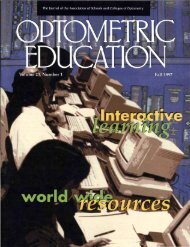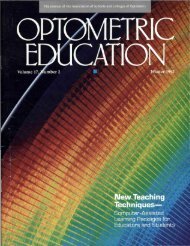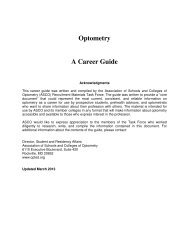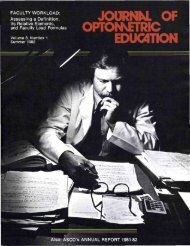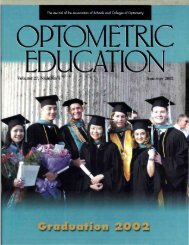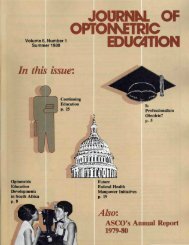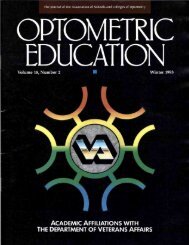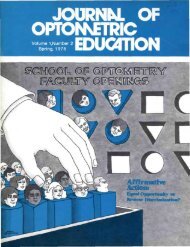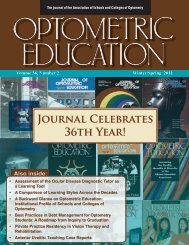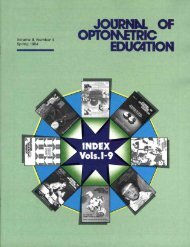Spring 1992, Volume 17, Number 3 - Association of Schools and ...
Spring 1992, Volume 17, Number 3 - Association of Schools and ...
Spring 1992, Volume 17, Number 3 - Association of Schools and ...
You also want an ePaper? Increase the reach of your titles
YUMPU automatically turns print PDFs into web optimized ePapers that Google loves.
TABLE 1<br />
Guidelines For Externship Programs<br />
1. Formulation <strong>of</strong> realistic, clearly defined aims, goals, <strong>and</strong> objectives.<br />
2. Implementation <strong>of</strong> a means <strong>of</strong> preceptor/site selection which fulfills the institution's<br />
educational expectations. ;<br />
3. Dedication to a system <strong>of</strong> educating the preceptors on their role in the teaching<br />
process.<br />
4. Initiation <strong>of</strong> an equitable means <strong>of</strong> assigning students to externships.<br />
5. Utilization <strong>of</strong> a means <strong>of</strong> summative <strong>and</strong> formative evaluation.<br />
come. 9 In terms <strong>of</strong> an externship, the<br />
objectives were developed to represent<br />
the discreet, observable actions<br />
<strong>and</strong> abilities which the extern must<br />
successfully demonstrate to the preceptor<br />
in an actual patient encounter.<br />
Guideline #2: Preceptor/<br />
Site Selection<br />
The selection <strong>of</strong> preceptors proved<br />
to be a challenging aspect <strong>of</strong> restructuring<br />
the externship program. Of<br />
particular importance was the decision<br />
to include private practices in<br />
addition to clinical facilities. Although<br />
questions <strong>of</strong> validity have been raised<br />
in regard to private practice externships,<br />
10 a similar approach in medicine<br />
11 has proven successful.<br />
Care was taken to objectively<br />
evaluate both the potential preceptor<br />
<strong>and</strong> the practice. Evaluation encompassed,<br />
but was not limited to, input<br />
from other colleagues within the<br />
practitioner's community, <strong>of</strong>ficers <strong>of</strong><br />
state <strong>and</strong> local optometric societies,<br />
state board members, <strong>and</strong> other<br />
knowledgeable references. The purpose<br />
<strong>of</strong> the inquiry was to gather<br />
information regarding the practitioner's<br />
philosophies <strong>of</strong> practice, dedication<br />
to optometry, <strong>and</strong> st<strong>and</strong>ing<br />
within the pr<strong>of</strong>ession.<br />
The practice environment was<br />
assessed in terms <strong>of</strong> patient volume<br />
<strong>and</strong> diversity, available instrumentation,<br />
<strong>and</strong> physical layout. A key factor<br />
was the scope <strong>of</strong> practice. Specialized<br />
practice settings which <strong>of</strong>fered limited<br />
optometric services were viewed<br />
as a potential hindrance to the student<br />
in terms <strong>of</strong> grasping optometry's<br />
primary care mission.<br />
Site visitations which would detail<br />
<strong>and</strong> document on st<strong>and</strong>ardized forms<br />
the practitioner's qualifications to<br />
serve as a preceptor were deemed<br />
vital. Consequently, the College<br />
began supporting on-site evaluations<br />
with resources <strong>and</strong> faculty/administrative<br />
release time in line with the<br />
approach reported by Wilson 5 <strong>and</strong><br />
Ruskiewicz. 12<br />
Site visits have afforded an opportunity<br />
to record preceptor interviews<br />
<strong>and</strong> <strong>of</strong>fice tours via videotape. This<br />
allowed the preceptor to be reviewed<br />
by other members <strong>of</strong> the administrative<br />
team in addition to becoming an<br />
excellent resource for students contemplating<br />
future externship assignments.<br />
Practitioners who successfully fulfilled<br />
the qualifications <strong>of</strong> the College<br />
formalized their commitment by<br />
signing a Memor<strong>and</strong>um <strong>of</strong> Agreement.<br />
This agreement detailed the<br />
obligations <strong>and</strong> responsibilities <strong>of</strong> all<br />
parties involved within the program.<br />
Once signed <strong>and</strong> approved by the administration,<br />
the preceptors were<br />
granted adjunct faculty status.<br />
Finally, a means <strong>of</strong> limiting the size<br />
<strong>of</strong> the preceptor pool was implemented.<br />
The College has addressed<br />
this issue by correlating the number<br />
<strong>of</strong> locations with the current demographics<br />
<strong>of</strong> the student body. By<br />
limiting the program relative to class<br />
size <strong>and</strong> the home states <strong>of</strong> enrolled<br />
students, the institution is better able<br />
to monitor the program.<br />
Guideline #3:<br />
Preceptor Education<br />
Because the ability <strong>of</strong> a preceptor<br />
to successfully fulfill the obligations<br />
<strong>of</strong> a teaefeer can never be assumed,<br />
the College has committed itself to<br />
a concentrated program <strong>of</strong> preceptor<br />
education. The approach has been<br />
diversified to include printed materials<br />
(i.e., h<strong>and</strong>books, protocol guides,<br />
etc.), personal counseling by the externship<br />
administrators, <strong>and</strong> formal,<br />
in-house instructional forums. At all<br />
levels, the format has attempted to<br />
address who the preceptors will be<br />
teaching, what they are to teach, <strong>and</strong><br />
how they are to teach.<br />
The provision <strong>of</strong> an externship<br />
h<strong>and</strong>book represented the first step<br />
in the process <strong>of</strong> educating preceptors.<br />
The h<strong>and</strong>book was a clear <strong>and</strong><br />
simple way <strong>of</strong> providing an overall<br />
framework for the adjunct faculty<br />
members. Within it, the expectations<br />
<strong>of</strong> the program were precisely stated<br />
in regard to each educational objective.<br />
Sections have been devoted to<br />
topics such as evaluation <strong>and</strong> grading,<br />
guidelines for student dress <strong>and</strong><br />
conduct, obligations <strong>of</strong> the preceptor<br />
to the student <strong>and</strong> to the institution,<br />
<strong>and</strong> criteria for the review <strong>of</strong> the externship<br />
experience. Samples <strong>of</strong><br />
forms which are used during the<br />
course <strong>of</strong> the rotation are also included<br />
with a detailed explanation <strong>of</strong><br />
how each is to be completed. Finally,<br />
a portion <strong>of</strong> the h<strong>and</strong>book was devoted<br />
to a review <strong>of</strong> teaching principles.<br />
Special emphasis was placed<br />
upon techniques which have proven<br />
beneficial to previous externship<br />
students.<br />
While the h<strong>and</strong>book provides instructions<br />
at the individual level,<br />
externship forums have proven to be<br />
the most effective means <strong>of</strong> educating<br />
<strong>and</strong> updating large groups <strong>of</strong> preceptors.<br />
Forums are typically held once<br />
or twice a year with the focus <strong>of</strong> required<br />
participation being upon new<br />
members <strong>of</strong> the adjunct faculty team.<br />
The format allows for the free exchange<br />
<strong>of</strong> ideas, observations, <strong>and</strong><br />
concerns <strong>of</strong> the preceptors, institutional<br />
faculty, <strong>and</strong> administration.<br />
Perhaps the most important concept<br />
to be stressed in the forums is<br />
that optometric education is a dynamic<br />
process. In general, learning is<br />
hindered when the student is placed<br />
in the passive role <strong>of</strong> an observer. The<br />
preceptors are educated to the necessity<br />
<strong>of</strong> active student involvement in<br />
the diagnosis, treatment, <strong>and</strong> management<br />
<strong>of</strong> ocular conditions. Conversely,<br />
preceptors are informed <strong>and</strong><br />
warned against the mentality <strong>of</strong><br />
involving students so aggressively<br />
that they begin viewing them as "free<br />
labor." In reality, the added time<br />
needed to critique <strong>and</strong> comment on<br />
the students' work may actually<br />
reduce the preceptor's regular number<br />
<strong>of</strong> doctor-patient interactions<br />
during the course <strong>of</strong> an externship.<br />
Finally, as with other disciplines, 13<br />
preceptors must learn to embrace the<br />
88 Optometric Education



